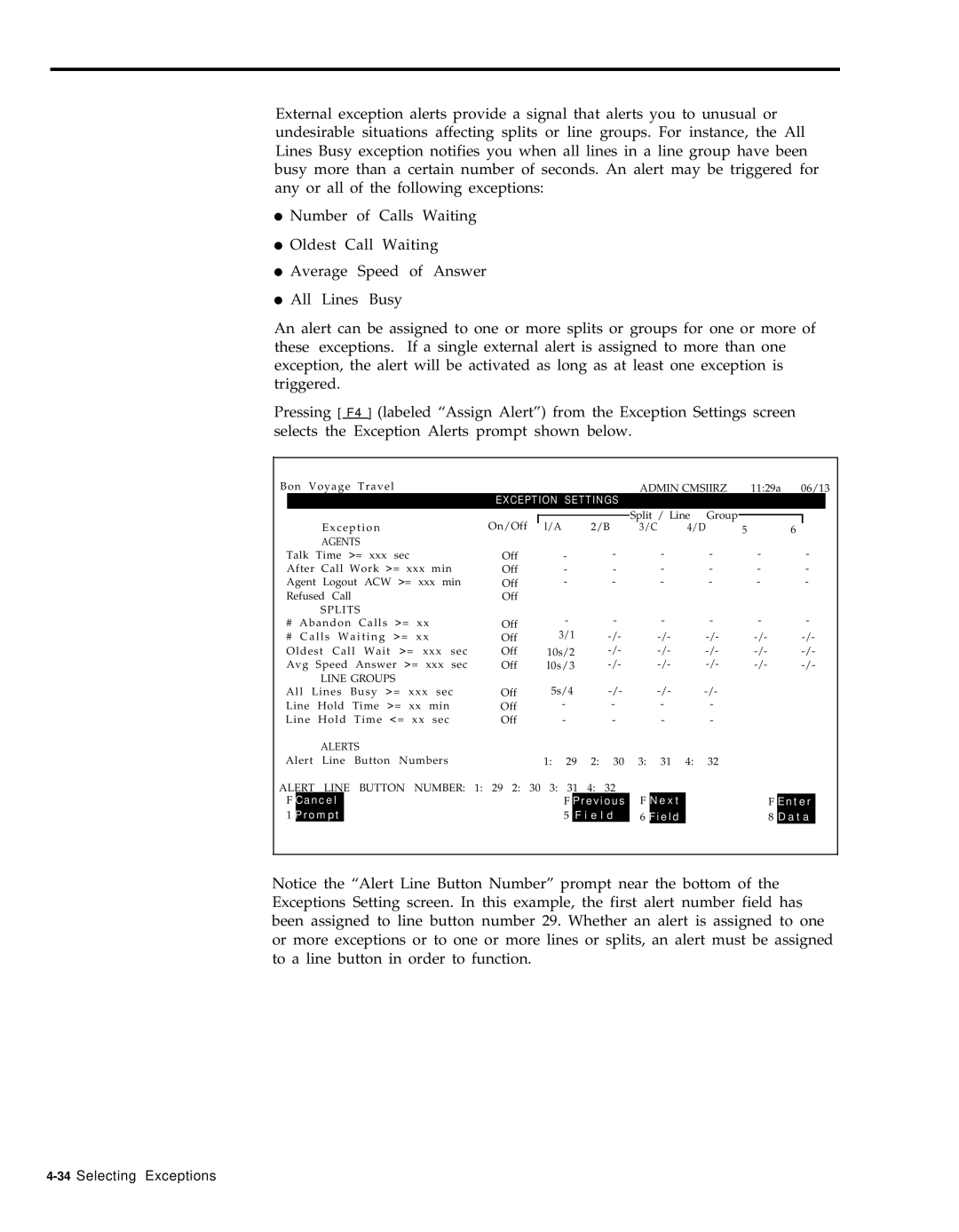
External exception alerts provide a signal that alerts you to unusual or undesirable situations affecting splits or line groups. For instance, the All Lines Busy exception notifies you when all lines in a line group have been busy more than a certain number of seconds. An alert may be triggered for any or all of the following exceptions:
●Number of Calls Waiting
●Oldest Call Waiting
●Average Speed of Answer
●All Lines Busy
An alert can be assigned to one or more splits or groups for one or more of these exceptions. If a single external alert is assigned to more than one exception, the alert will be activated as long as at least one exception is triggered.
Pressing [ F4 ] (labeled “Assign Alert”) from the Exception Settings screen selects the Exception Alerts prompt shown below.
Bon Voyage | Travel |
|
|
|
|
|
|
| ADMIN CMSIIRZ | 11:29a | 06/13 | ||||||||||||
|
|
|
|
|
| EXCEPTION SETTINGS |
|
|
|
|
|
|
|
|
|
|
| ||||||
|
|
|
|
|
| On/Off |
|
|
|
|
|
| Split / Line | Group |
|
|
|
|
|
|
| ||
|
|
|
|
|
|
| l/A |
|
|
|
|
|
|
|
|
| |||||||
|
|
| Exception |
| 2/B | 3/C | 4/D | 5 |
|
| 6 |
|
|
| |||||||||
|
|
| AGENTS |
|
|
|
|
|
| - | - |
| - |
| - |
| - |
|
| ||||
Talk Time >= xxx sec | Off |
| - |
|
|
|
|
|
|
| |||||||||||||
After Call Work >= xxx min | Off |
| - |
|
| - | - |
| - |
| - |
| - |
|
| ||||||||
Agent Logout ACW >= xxx min | Off |
| - |
|
| - | - |
| - |
| - |
| - |
|
| ||||||||
Refused Call |
| Off |
|
|
|
|
|
|
|
|
|
|
|
|
|
|
|
| |||||
|
|
| SPLITS |
|
|
| - |
|
| - | - |
| - |
| - |
| - |
|
| ||||
# Abandon Calls >= xx | Off |
|
|
|
|
|
|
|
| ||||||||||||||
# Calls Waiting >= xx | Off |
| 3/1 |
|
|
|
|
|
| ||||||||||||||
Oldest Call Wait >= xxx sec | Off | 10s/2 |
|
|
|
|
|
| |||||||||||||||
Avg Speed Answer >= xxx sec | Off | l0s/3 |
|
|
|
|
|
| |||||||||||||||
|
|
| LINE GROUPS |
|
| 5s/4 |
|
|
|
|
|
|
|
| |||||||||
All Lines Busy >= xxx sec | Off |
|
|
|
|
|
|
|
| ||||||||||||||
Line Hold Time >= xx min | Off |
| - |
|
| - | - |
| - |
|
|
|
|
|
|
| |||||||
Line Hold Time <= xx sec | Off |
| - |
|
| - | - |
| - |
|
|
|
|
|
|
| |||||||
|
|
| ALERTS |
|
|
|
|
|
|
|
|
|
|
|
|
|
|
|
|
|
| ||
Alert | Line | Button Numbers |
|
| 1: | 29 | 2: | 30 | 3: 31 | 4: | 32 |
|
|
|
|
|
|
| |||||
ALERT | LINE | BUTTON NUMBER: | 1: 29 2: 30 | 3: | 31 | 4: | 32 |
|
|
|
|
|
|
|
|
|
|
| |||||
F | Cancel |
|
|
|
|
| F | Previous | F | Next |
|
|
| F | Enter |
| |||||||
1 | Prompt |
|
|
|
|
| 5 | F i e l d | 6 | Field |
|
|
| 8 | Data |
| |||||||
|
|
|
|
|
|
|
|
|
|
|
|
|
|
|
|
|
|
|
|
|
|
|
|
Notice the “Alert Line Button Number” prompt near the bottom of the Exceptions Setting screen. In this example, the first alert number field has been assigned to line button number 29. Whether an alert is assigned to one or more exceptions or to one or more lines or splits, an alert must be assigned to a line button in order to function.
